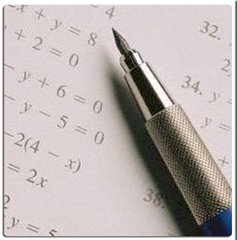If l, m, and n are positive integers such that l < m < n and n < 4, then m =
(A) 0 (B) 1 (C) 2 (D) 3 (E) 4
Thursday, May 3, 2007
Subscribe to:
Post Comments (Atom)
is intended to be a spot where any student preparing for GRE can discuss study topics,find or provide tips & works towards a top score along with other students working for the same goal.Answer"GRE WORD OF THE DAY", "GRE SENTENCE COMPLETION OF THE DAY", "GRE ANALOGY OF THE DAY", "GRE ANTONYM OF THE DAY", "GRE MATH PROBLEM OF THE DAY", "GRE ALGEBRA QUESTION OF THE DAY", "GRE GEOMETRY QUESTION OF THE DAY"& "GRE PASSAGE OF THE WEEK". To get a top score,the first step of the ladder starts from here.

7 comments:
C
C
Can any body tell me...
Why D is not a correct answer?
positive integers are set of positive whole number...
as number line indicates integers to be the set of whole number and their opposite
so obviously
0 <1 <2 <3 <4 <5 <6 <7
now n must be 3 and so m is 2
not satisfied click on to this
http://www.mathgoodies.com/lessons/vol5/intro_integers.html
http://www.mathgoodies.com
/lessons/vol5/intro_integers.html
c
Post a Comment